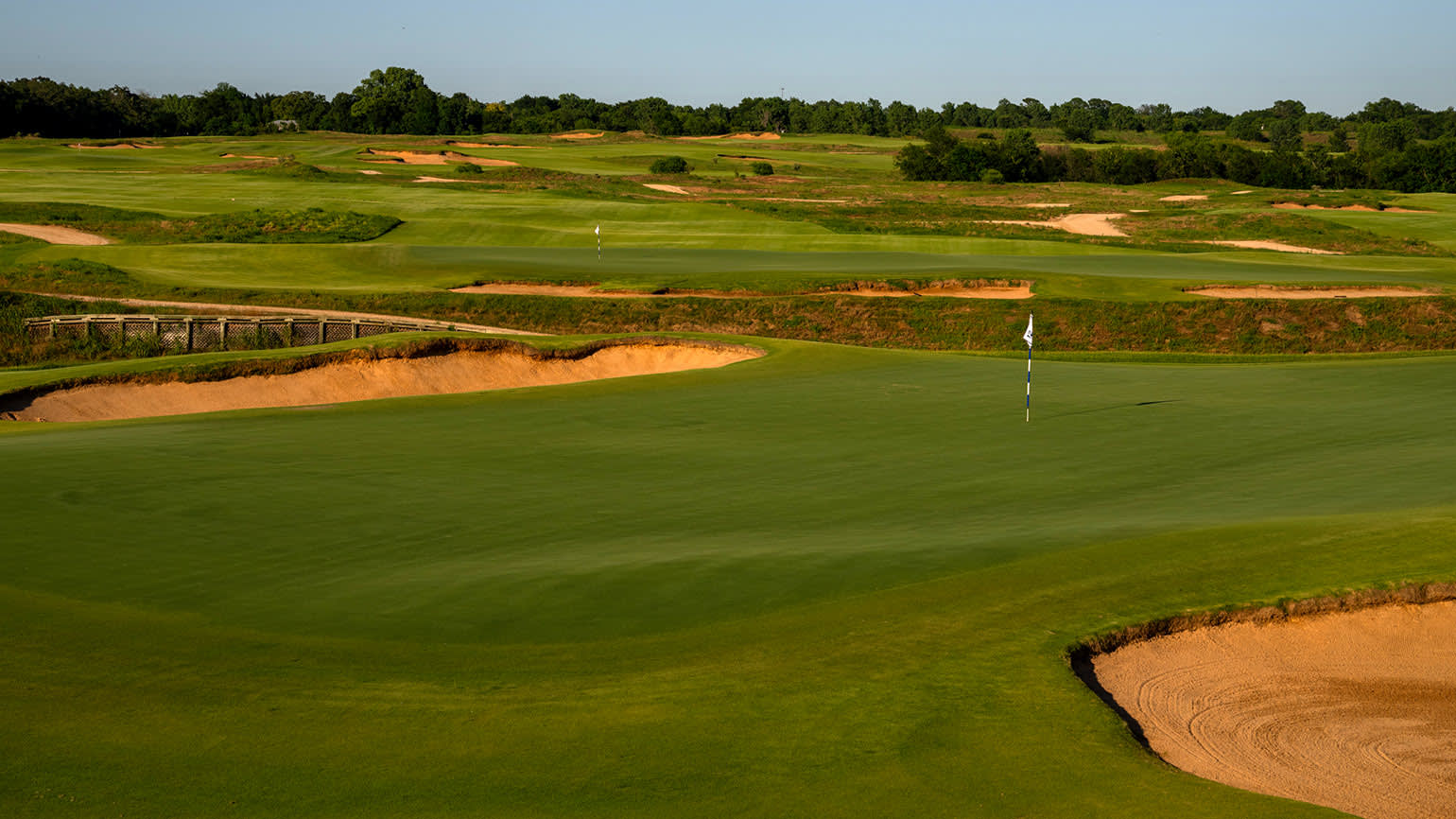Transformation at Trinity Forest Golf Club
Trinity Forest Golf Club looks like an idyllic patch of linksland that somehow got dropped into the middle of a secluded forest. It’s hard to believe that the golf course was actually built on an illegal landfill just a few minutes from downtown Dallas.
The transformation that took place there is not only surprising, it’s an inspiring example of how golf can be a vehicle for positive change. Developing the course rehabilitated a degraded landscape, brought resources into an underserved community, and created opportunities for people to connect and have their lives shaped for the better by the game we love – but it took a lot of vision, commitment and hard work to go from landfill to the host course of this year’s U.S. Junior Amateur.
When founder and club president Jonas Woods first toured the site, it looked to him like a rolling meadow that was perfect for golf. He didn’t realize that piles of construction debris sat just beneath the surface. “The property was covered in tall grasses and surrounded by this magnificent forest,” said Woods. “I thought it had the potential to be a beautiful, very links-like golf course. But if you really looked closely, every now and again you’d see an artifact of what the site really was, a tire poking out of the ground or something and you’d wonder where that came from.”
The fact that the site was a former landfill now owned by the City of Dallas presented some unique challenges, but it was also a rare opportunity to create a new golf course capable of hosting elite championships in the heart of a major metropolitan area. The city was an enthusiastic partner in the project because building the course would rehabilitate the degraded site and bring valuable investment into the community. Woods and fellow founder Ron Spears also envisioned building a First Tee Center at the course and supporting many other community initiatives there. However, none of that could happen without a great golf course.
Woods approached Bill Coore and Ben Crenshaw to see if they’d be interested in designing the course. Among the most highly regarded golf course architects of the modern era, Coore and Crenshaw are probably best known for working with great natural sites in remote locations. Designing a championship golf course on a former landfill in the heart of a major city was a bit of a departure for them to say the least, but they were intrigued by the possibilities and the challenge.
“For me personally, the site and the project had some real interest,” said Coore. “The land was rumpled like it needed to be ironed – it looked like wind-blown links contours, and it was appealing to create something in a part of the city that hadn’t seen as much growth.”
“Now, with all that being said, I’m quite certain that if we had known all the ramifications and restrictions of working with a landfill, we probably would have passed,” said Coore with a chuckle.
Part of the reason why the site had wrinkled terrain that appealed so much to Coore was because the landfill had not been properly maintained. Erosion and settling had compromised the integrity of an impermeable layer of clay that had been placed over the debris to “cap” it. To bring the site up to standards, some areas had to be recapped at the appropriate depth. Once the cap was fully in place, it could not be disturbed. Trees aren’t even allowed on the site because their roots can compromise the integrity of the cap.
The next step in the process was covering the site with soil that was conducive to growing grass. More than 750,000 cubic yards of sandy, gravelly, loam was excavated on-site and spread across the golf course for the Coore and Crenshaw team to shape their vision into reality. Superintendent Kasey Kauff was the first full-time employee at Trinity Forest, hired because of his familiarity with the combination of zoysiagrass fairways and bermudagrass greens they wanted to use at the course.
“We wanted tight, firm and fast conditions throughout the year,” said Kauff “and the variety of zoysiagrass we have, which is now called ‘Trinity’ since we were the first to use it, helps us make that happen in a climate with hot summers and sometimes surprisingly cold winters.” Zoysiagrass is drought tolerant and performs well in hot and humid weather. It also handles cold temperatures better than many other warm-season grasses and its rigid leaf blades provide a high-quality dormant playing surface during the winter months in Dallas.
Kauff and the team at Trinity Forest also worked with the neighboring Trinity River Audubon Center to plant 90 acres of Texas Blackland Prairie vegetation in the native areas surrounding the golf holes. “I loved the idea of restoring this habitat,” said Kauff, “because Blackland Prairie is a very endangered ecosystem and I knew that once we had it established it would tolerate our climate without any watering. We don’t have any sprinklers out in the native areas, we mow them a couple of times a year and spray weeds, and that’s about it.”
One of the biggest challenges for Kauff and his team since the course opened has been drainage. Water that moves through the sandy loam soil eventually hits the impermeable clay cap and pops to the surface in unexpected places. “We have added miles of drainage since grow-in,” said Kauff. “We added new drainage this year, it never ends. That’s just something that comes with the unique characteristics of the site.”
The journey to create Trinity Forest was not easy, but the outcome is inspiring. “It’s golf in the old-world way,” said Coore. “It may be in south Dallas, far, far from an ocean, but when you’re walking out there and see the native grasses, and the twists and turns of the contours, and how the greens are married to the ground – it reminds me of being on the other side of the Atlantic playing a course that has been there for 500 years!”
It’s also exciting to see the vision of Trinity Forest as a community asset being realized. USGA president Fred Perpall calls Dallas home and was an early founding member of the club. “For me, it was more than the golf itself that was attractive, it was the purpose-driven nature of the project,” said Perpall. “We had this opportunity to bring big philanthropic golf events back to the heart of Dallas, to an underserved part of town. To turn a blight in the community into an asset, to create a positive environment out of a negative one.”
Today, the First Tee – Greater Dallas has a dedicated learning center, practice range and short course at Trinity Forest. The SMU men’s and women’s golf teams call Trinity Forest home. The course has hosted elite professional and amateur golf championships and local charities use it at minimal cost to fundraise for their work in the community. The environment at Trinity Forest has also been transformed from a landfill to a beautiful mix of firm, fast turf and native vegetation. “I think you’d be hard pressed to find a modern club that has accomplished more in its first 10 years,” said Perpall.
George Waters is the USGA’s assistant director, Green Section education. Email him at gwaters@usga.org.
















